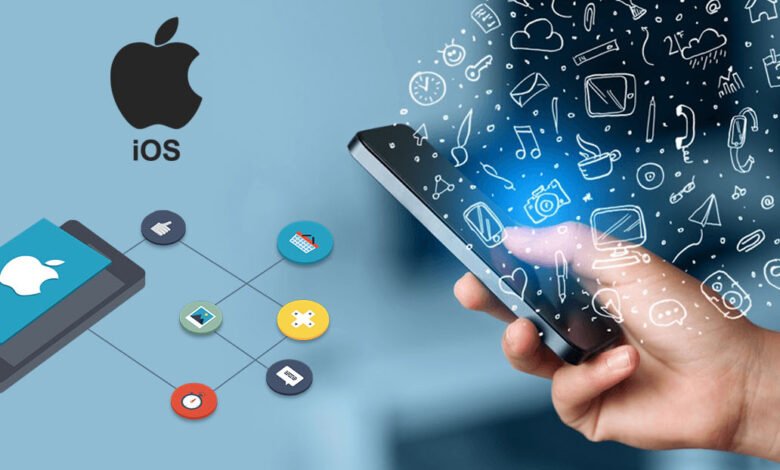iOS Mobile App Development – A Comprehensive Guide

In the fast-paced world of mobile app development, iOS stands out as an essential competitor. With its smooth design, robust security features, and extensive user stand, iOS offers developers a productive platform to display their creativity. This article will be a complete guide for those progressing into the iOS mobile app development empire.
Getting Started with iOS Development
Begin on the journey of iOS development requires a solid foundation. This section will guide you through the initial steps, helping you set up your development environment, choose the correct programming language, and provide a comprehensive overview of Xcode, the essential tool for crafting unusual iOS applications. Let’s search into the crucial features that will pave the way for your success in the exciting empire of iOS development.
- Setting up the Development Environment
- Choosing the Right Programming Language
- Overview of Xcode
Setting up the Development Environment
The first step in iOS mobile app development is creating a beneficial workspace. It involves downloading Xcode, Apple’s official IDE, and composing it to align with your project requirements. Xcode provides a unified interface for coding, testing, and debugging elegant the development process.
Choosing the Right Programming Language
iOS developers primarily use Instant or Objective-C for coding. Swift, introduced by Apple in 2014, has secured popularity for its simplicity and organization. Objective-C, the mature language, still finds use in maintaining legacy projects. The choice between these languages depends on project specifications and developer preferences.
Overview of Xcode
Xcode acts as the command center for iOS development. It offers a suite of tools, including an interface builder, code editor, and sort-out console. Familiarizing yourself with Xcode is crucial for an ideal development experience.
Fundamentals of iOS App Design
Understanding the core principles of iOS app design is related to mastering the art of creating a captivating journey for your users. In this segment, we’ll explore the intricacies of user interface (UI) design, highlight the importance of reactive layouts, and search into the integration of graphics and vitality. Join us as we solve the secrets to designing elegant, pleasing, and user-friendly iOS applications that leave a lasting impression on your audience.

- User Interface (UI) Design Principles
- Creating Responsive and User-Friendly Layouts
- Integration of Graphics and Animations
User Interface (UI) Design Principles
Creating an engaging user interface is most important for the success of an iOS app. Adhering to Apple’s Human Interface Guidelines ensures a compatible and unlearned user experience. Pay attention to factors like navigation, layout, and color projects to craft an elegant, pleasing app.
Creating Responsive and User-Friendly Layouts
iOS devices come in some sizes and resolutions. Designing responsive layouts ensures your app looks and functions ideally across different devices. Utilize Auto Layout to adapt your app’s interface to the diverse iOS ecosystem.
Integration of Graphics and Animations
Visual appeal enhances the user experience. Incorporate high-quality graphics and indefinite animations to make your app visually appealing. Strike a balance between creativity and clarity to avoid huge the user.
Core Components of iOS Apps
Diving into the heart of iOS app development, we’ll dissect the essential pieces that form the backbone of your applications. From untangling the role of ViewControllers to navigating through the complexity of Navigation Controllers and Tab Bars, we’ll provide an in-depth exploration. Join us in this section to understand the basic building blocks that empower your iOS apps with functionality, organization, and an ideal user experience.
- Understanding ViewControllers
- Exploring Navigation Controllers and Tab Bars
- Introduction to TableViews and Collection Views
Understanding ViewControllers
ViewControllers serve as the building blocks of an iOS app. Gain a thorough understanding of their role in managing views, user interactions, and data flow. Effectively utilizing ViewControllers is critical to creating a structured and organized app architecture.
Exploring Navigation Controllers and Tab Bars
Navigation Controllers and Tab Bars facilitate seamless navigation within an app. Mastering their implementation enhances the user’s ability to explore and interact with different sections of your application.
Introduction to TableViews and Collection Views
TableViews and CollectionViews are essential for displaying dynamic content in iOS apps. Learn how to populate these components with data and customize their appearance to create visually appealing lists and grids.
iOS App Development Best Practices
Elevating your iOS app development skills involves more than just writing code—it requires attaching to established best practices. This section will guide you through writing clean and efficient code, using design patterns for expandability, and executing robust error control. Join us on a journey to discover the practices that increase the quality of your code and contribute to the long-term success and reparability of your iOS applications.

- Writing Clean and Efficient Code
- Utilizing Design Patterns for Scalability
- Implementing Error Handling and Debugging Techniques
Writing Clean and Efficient Code
Maintaining clean and efficient code is crucial for long-term project supportable. Follow best practices such as movable, proper commenting, and agreement to coding standards. It ensures easy collaboration and code readability.
Utilizing Design Patterns for Scalability
Design patterns such as MVC (Model-View-Controller) or MVVM (Model-View-ViewModel) increase the expandability and reparability of your regulations. Select a design that aligns with your project’s attachment and future growth.
Implementing Error Handling and Debugging Techniques
Bugs in software development. Proficiently using Xcode’s debugging tools and implementing robust error-handling mechanisms ensures a smooth debugging process. Thorough testing is vital to identify and rectify issues before the app reaches the user.
Testing and Debugging on iOS
Creating a successful iOS app extends beyond coding; it involves rigorous testing and effective debugging. In this section, we’ll explore the comprehensive world of testing frameworks, delve into the powerful debugging tools within Xcode, and emphasize the importance of testing your app on various iOS devices. Join us as we unravel the strategies that guarantee your app’s stability, identify potential issues, and ultimately deliver your users a polished and reliable experience.

- Overview of Testing Frameworks
- Debugging Tools in Xcode
- Running Tests on Different iOS Devices
Overview of Testing Frameworks
iOS development offers testing frameworks like XCTest and third-party options like Quick and Nimble. Understanding the fundamentals of unit and UI testing is essential for delivering a stable and bug-free app.
Debugging Tools in Xcode
Xcode provides an arrangement of tools for debugging, such as requiring LLDB (Low-Level Debugger) and Instruments. Familiarize yourself with these tools to identify and resolve issues efficiently during development.
Running Tests on Different iOS Devices
Testing your app on different iOS devices ensures compatibility and a compatible user experience. Utilize the iOS Simulator for testing and testing on physical devices to address any device-specific challenges.
App Store Submission Process
The App Store submission process marks the pivotal transition from development to user availability. This section will guide you through the correct steps to arrange your app for submission. It includes crafting compelling app descriptions, providing high-quality observations, and ensuring your app connects to Apple’s stringent guidelines. Join us as we solve the intricacies of the submission process, offering tips for a successful launch and surfacing the way for your app to reach a global audience through the great App Store.
- Preparing the App for Submission
- Following App Store Guidelines
- Tips for a Successful App Launch
Designing the App for Submission
Before submitting your app to the App Store, ensure it connects all guidelines defined by Apple. It includes generating attractive app descriptions, giving high-quality screenshots, and preparing promotional materials.
Following App Store Guidelines
Apple has exact guidelines to maintain the quality and security of apps on the App Store. Attaching these guidelines ensures your app’s approval and reflects positively on your developer account.
Tips for a Successful App Launch
A successful app launch involves strategic planning and marketing. Generate pre-launch buzz, engage with potential users, and utilize social media platforms to create anticipation. Additionally, gather user feedback during beta testing to make necessary improvements.
Future Trends in iOS Development
As the landscape of iOS development continues to evolve, staying ahead requires a keen eye on appear trends. In this section, we’ll explore the future of iOS development, from the simplifications provided by SwiftUI to combining augmented reality (AR) features. Additionally, we’ll discuss the importance of keeping side by side with iOS updates and innovations, ensuring your apps remain at the forefront of technology. Join us as we search into the exciting prospects that the future holds for iOS developers, encouraging you to accept innovation and navigate the ever-changing world of mobile app development.

- Embracing SwiftUI for Declarative UI
- Integration of Augmented Reality (AR) Features
- Keeping Up with iOS Updates and Innovations
Embracing SwiftUI for Declarative UI
SwiftUI, introduced by Apple, simplifies the process of building user interfaces with a declarative syntax. Accept SwiftUI can enhance productivity and open new possibilities for original UI design.
Integration of Augmented Reality (AR) Features
Augmented reality is secure in the mobile app landscape. Consider integrating AR features into your iOS app to provide users with captivating and interactive experiences.
Keeping Up with iOS Updates and Innovations
Apple consistently delivers updates and introduces new features to the iOS ecosystem. Stay informed about these updates to support the latest technologies and supply users with cutting-edge experiences.
Conclusion
In conclusion, iOS mobile app development offers a beneficial journey for developers searching to create understanding and innovative applications. By learning the fundamentals, accepting best practices, and staying level of industry trends, developers can successfully navigate the energetic landscape of iOS development.
FAQs
How important is UI design in iOS app development?
UI design is pivotal as it directly impacts the user experience. Following Apple's guidelines ensures a consistent and optically appealing design.
What are the essential components of an iOS app?
ViewControllers, Navigation Controllers, Tab Bars, TableViews, and CollectionViews are fundamental components of iOS apps.
How can I ensure my app's success on the App Store?
Prepare a high-quality app, attach to App Store guidelines, and devise effective pre-launch marketing strategies.
What is the significance of staying updated with iOS innovations?
Staying updated allows developers to leverage the latest technologies and offer users cutting-edge features and experiences.








